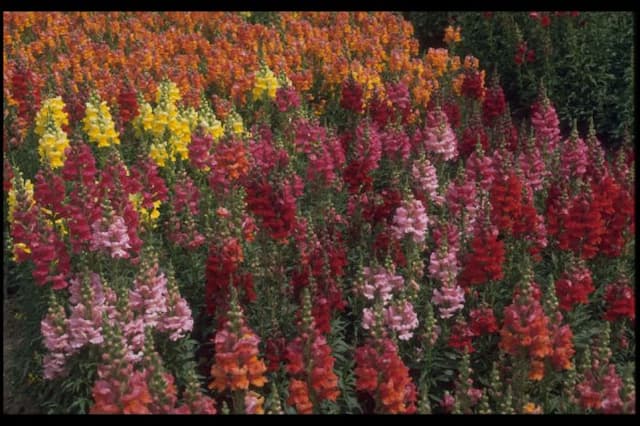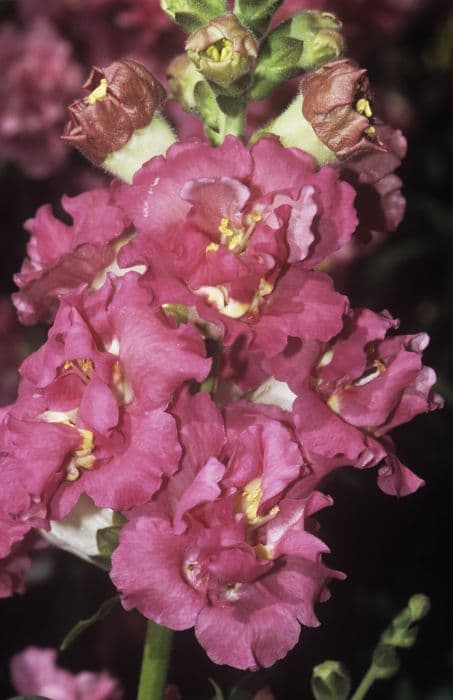Shrubby Veronica Hebe brachysiphon

ABOUT
The plant commonly known as Hebe brachysiphon is an evergreen shrub that boasts a bushy and rounded habit. It features dense foliage consisting of small, oval, to lance-shaped glossy green leaves that are arranged in opposing pairs along the stems. The leaves give the plant a lush and vibrant appearance year-round. In terms of flowers, this plant produces spikes of small blooms that can range in color from white to pale violet-blue, adding a splash of subtle color to the foliage. These flowers are tubular and have a characteristic flared opening, grouped tightly together in racemes at the tips of the branches. The overall impression of the Hebe brachysiphon is one of a compact and neat shrub that has textural foliage and attractive flowers which can bring a decorative element to gardens or landscapes where it is planted. Its appearance makes it suitable for various uses, including border planting, ground cover, and as part of ornamental garden arrangements.
About this plant
 Names
NamesSynonyms
Hebe, Shrubby Veronica
Common names
Veronica brachysiphon, Hebe salicifolia, Veronica salicifolia, Veronica latisepala, Hebe latisepala
 Toxicity
ToxicityTo humans
Hebe brachysiphon, commonly known as Hebe, has not been widely reported as a toxic plant to humans. While not considered highly toxic, like many plants, it may cause mild irritation or an allergic reaction if ingested or if the sap comes in contact with skin in sensitive individuals. However, it is always best to handle plants with care and avoid ingesting any plant parts if you are unsure of their toxicity. If a person does consume Hebe and experiences symptoms such as nausea, vomiting, or diarrhea, medical attention should be sought.
To pets
Hebe brachysiphon, known simply as Hebe, is not commonly listed as a toxic plant to pets such as cats and dogs. While the plant is not considered highly toxic, it is still advisable to prevent pets from ingesting plants. If a pet were to ingest Hebe, they might experience mild gastrointestinal upset, but serious toxicity is unlikely. However, any ingestion of plant material can potentially lead to symptoms such as vomiting, diarrhea, or drooling, particularly in pets with sensitive stomachs or if a large amount is consumed. If a pet exhibits these symptoms or any unusual behavior after ingesting Hebe, it is recommended to consult with a veterinarian.
 Characteristics
CharacteristicsLife cycle
Perennials
Foliage type
Evergreen
Color of leaves
Green
Flower color
White
Height
3 feet (0.91 meters)
Spread
3 feet (0.91 meters)
Plant type
Shrub
Hardiness zones
8
Native area
New Zealand
Benefits
 General Benefits
General Benefits- Ornamental Appeal: Adds aesthetic value to gardens with its attractive foliage and flowers.
- Low Maintenance: Requires minimal care once established, making it ideal for busy gardeners.
- Drought Tolerant: Survives with limited water supply, suitable for xeriscaping.
- Wildlife Attraction: Flowers provide nectar for bees and other beneficial insects.
- Versatility: Can be used in various garden designs, from borders to containers.
- Evergreen: Retains foliage throughout the year, providing constant garden interest.
 Medical Properties
Medical PropertiesThis plant is not used for medical purposes.
 Air-purifying Qualities
Air-purifying QualitiesThis plant is not specifically known for air purifying qualities.
 Other Uses
Other Uses- Winter Interest: Hebe brachysiphon, commonly known as Shrubby Veronica, maintains green foliage during winter, providing color and interest in dull winter gardens.
- Seaside Gardens: Due to its tolerance to sea winds and salt spray, Shrubby Veronica can be used in coastal landscapes for stabilizing soil and adding greenery.
- Bonsai: Some gardening enthusiasts may use Shrubby Veronica for bonsai due to its dense foliage and woody stems, which can be trained into artistic shapes.
- Erosion Control: This plant's dense root system makes it suitable for slopes and banks where soil erosion is a concern.
- Landscape Filling: Its bushy and evergreen nature allows Shrubby Veronica to serve as an excellent filler in garden beds and borders, providing a backdrop for flowering plants.
- Urban Landscaping: Shrubby Veronica is resilient to urban pollution, making it a good choice for city gardens and public spaces.
- Pollinator Support: Although not widely known for this, Shrubby Veronica can attract bees and butterflies to the garden when in bloom, helping to support local ecosystems.
- Low Hedge: Shrubby Veronica can be closely planted and trimmed to form a low, informal hedge or border in garden settings.
- Crafts: Dried sprigs of Shrubby Veronica might be used in floral arrangements or wreaths because of their attractive foliage and structure.
- Educational Tool: Shrubby Veronica can be used in educational settings such as schools to teach students about plant growth and gardening practices.
Interesting Facts
 Feng Shui
Feng ShuiHebe is not used in Feng Shui practice.
 Zodiac Sign Compitability
Zodiac Sign CompitabilityHebe is not used in astrology practice.
 Plant Symbolism
Plant Symbolism- Youthfulness: The genus name Hebe comes from the Greek goddess of youth, representing the plant’s association with youth and rejuvenation.
- Enduring Love: Hebe plants often symbolize love that withstands the test of time, as they are evergreen and resilient in various conditions.
- Unity: With its clustered flowers, Hebe is seen to symbolize unity, where the individual blooms come together to form a whole, much like a family or community.
 Water
WaterThe Hebe, also known as the Shrubby Veronica, should be watered regularly to maintain moist soil, especially during its growing season in the spring and summer. Typically, it should be watered once a week, but this can vary depending on the climate and weather conditions; in hotter periods you may need to water more frequently. It's important to thoroughly soak the soil with about a gallon of water per watering session, ensuring it reaches the roots without waterlogging the plant since too much water can cause root rot. During the cooler months, reduce watering to every two or three weeks to prevent overwatering as the plant's water needs decrease.
 Light
LightThe Hebe plant, commonly known as the Shrubby Veronica, thrives best in full sunlight to partial shade conditions. It should be placed in a spot where it can receive at least six hours of direct sunlight daily. While this plant can handle some shade, too much can lead to sparse foliage and fewer blooms. The ideal location would be one where morning sunlight is direct, and the afternoon light is dappled or partially shaded to protect it from the intense heat of the day.
 Temperature
TemperatureThe Shrubby Veronica prefers a temperate climate with temperatures ranging from 50 to 75 degrees Fahrenheit during the growing season, with an ideal temperature around 65 degrees Fahrenheit. While it can survive temperatures as low as 30 degrees Fahrenheit, it's important to protect it from prolonged frost. On the higher end, it can handle temporary spikes up to 80 degrees Fahrenheit, but consistently high temperatures can stress the plant.
 Pruning
PruningPruning the Shrubby Veronica is essential to maintain its shape, encourage bushier growth, and remove any dead or damaged branches. The best time to prune is in late winter or early spring before new growth begins. Prune annually, cutting back up to one-third of the plant’s size to keep it compact and healthy. Removal of spent flower spikes after blooming can also promote a second bloom in some species.
 Cleaning
CleaningAs needed
 Soil
SoilThe best soil mix for Hebe, commonly known as shrubby veronica, is well-draining soil with a loamy texture and includes a mixture of two parts peat moss, one part perlite or sand, and one part garden soil or compost. Hebe prefers slightly acidic to neutral pH levels, ranging from 6.5 to 7.5.
 Repotting
RepottingHebe, or shrubby veronica, generally should be repotted every two to three years to refresh the soil and provide room for growth. Choose a container only slightly larger than the previous one to prevent waterlogging.
 Humidity & Misting
Humidity & MistingShrubby veronica thrives in moderate to high humidity but is quite adaptable, so it can also tolerate drier conditions. No specific humidity level is critical, but aim for a range of 40-60% to keep your Hebe healthy.
 Suitable locations
Suitable locationsIndoor
Place shrubby veronica near a sunny window with some afternoon shade.
Outdoor
Plant shrubby veronica in an area with morning sun and partial afternoon shade.
Hardiness zone
8-11 USDA
 Life cycle
Life cycleHebe brachysiphon, commonly known as Hebe, begins its life cycle with seed germination occurring in favorable conditions of moisture and temperature. Seedlings emerge and develop into juvenile plants, characterized by rapid vegetative growth and development of compound leaves typical of the genus. As the plant matures, it enters the vegetative stage, establishing a strong root system and woody stems in preparation for flowering. The reproductive stage follows, with the Hebe producing inflorescences that are spikes of small, often purple to white flowers, which are pollinated by insects such as bees. After successful pollination, the flowers develop into small capsules containing seeds, completing the cycle when these seeds are dispersed to give rise to new plants. Throughout its life, Hebe brachysiphon may experience repeated cycles of vegetative growth and flowering, typically living for several years before declining due to age or environmental stresses.
 Propogation
PropogationPropogation time
Spring to summer
The Hebe brachysiphon, commonly known as Shrubby Veronica, can be propagated by semi-hardwood cuttings. The ideal time to take these cuttings is in the late summer or early fall when the new growth has begun to mature. To propagate by cuttings, a gardener should select healthy, non-flowering stems and cut segments that are approximately 4 to 6 inches long, ideally with several sets of leaves. The lower leaves should be removed, and the cut end can be dipped in rooting hormone to encourage root development. The prepared cuttings are then inserted into a pot with a well-draining potting mix, ensuring at least one set of leaves is above the soil surface. The pot should be placed in a warm, bright area but out of direct sunlight, and the soil should be kept consistently moist but not soggy. Roots typically develop within several weeks, after which the new Shrubby Veronica plants can be transplanted into individual pots or direct in the garden.





![Snapdragon [Pretty in Pink]](/_next/image?url=https%3A%2F%2Fplants-admin.emdemapps.com%2Fimages%2Fplants%2F%2Fimages%2F604b5cb3b5385.png&w=640&q=75)



